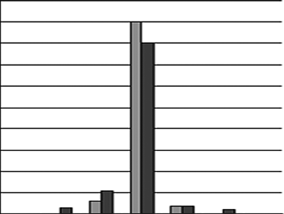Criterion of significance level for selection of order of spectral estimation of entropy maximum
DOI:
https://doi.org/10.3103/S0735272719050042Keywords:
AIC, BIC, random signal, voice signal, digital processing, spectral analysis, autoregression model, parametric methods, maximal entropy principle, Burg’s method, Akaike criterionAbstract
It is researched a wide class of parametric estimations of power spectral density based on principle of entropy maximum and autoregression observation model. At that there is distinguished the key parameter which is used model order. It is considered a problem of a priori uncertainty when true value of order is a priori unknown. It is proposed a new criterion for definition of order using finite sampling volume with purpose of overcome of the drawbacks of existing algorithms in conditions of small sampling. The principle of guaranteed significance level in a problem of complex statistic hypothesis verification is a basic principle of this criterion. In contrast to criteria of AIC, BIC, etc. this criterion is not related to determination of measurements inaccuracy, since it uses a conception of “significance level” of formed solution only. The efficiency of proposed criterion is researched theoretically and experimentally. An example of its application in a problem of spectral analysis of voice signals is considered. Recommendations about its practical application in the systems of digital signal processing are given.References
- KAY, S.M. Modern Spectral Estimation: Theory and Application. Prentice-Hall signal processing series, 1999.
- RABINER, L.R.; SCHAFER, R.W. Theory and Applications of Digital Speech Processing. Boston: Pearson, 2010.
- GIBSON, J. “Entropy power, autoregressive models, and mutual information,” Entropy, v.20, n.10, p.750, 2018. DOI: https://doi.org/10.3390/e20100750.
- MARPLE Jr., S.L. Digital Spectral Analysis with Applications. Prentice-Hall, 1987.
- CASTANIÉ, F. (ed.), Digital Spectral Analysis: Parametric, Non-Parametric and Advanced Methods. Wiley-ISTE, 2011. URI: https://www.wiley.com/en-us/Digital+Spectral+Analysis%3A+Parametric%2C+Non+Parametric+and+Advanced+Methods-p-9781848212770.
- SAVCHENKO, V.V. “The new concept of the software of statistical information processing on the basis of predictive function of probability theory,” Nauchnyye Vedomosti BelGU. Ser: Ekonomika. Informatiks, v.34/1, n.7, p.84, 2015. URI: http://dspace.bsu.edu.ru/handle/123456789/13130.
- LIU, C.-A.; KUO, B.-S.; TSAY, W.-J. “Autoregressive spectral averaging estimator,” IEAS Working Paper: academic research 17-A013. Institute of Economics. Taiwan, 2017. URI: https://ideas.repec.org/p/sin/wpaper/17-a013.html.
- ZAITSEV, E.O.; SYDORCHUK, V.E.; SHPILKA, A.N. “Application of the spectrum analysis with using Berg method to developed special software tools for optical vibration diagnostics systems,” Devices Methods Meas., v.7, n.2, p.186, 2016. DOI: https://doi.org/10.21122/2220-9506-2016-7-2-186-194.
- KAKORA, V.A.; GRINKEVICH, A.V. “Mathematical analysis of spectral estimation algorithms resolution,” Doklady BGUIR, n.3, p.20, 2017. URI: https://elibrary.ru/item.asp?id=29855484.
- MATLAB Examples. URI: https://www.mathworks.com/examples/signal/category/spectral-analysis.
- DING, J.; TAROKH, V.; YANG, Y. “Bridging AIC and BIC: a new criterion for autoregression,” IEEE Trans. Inf. Theory, v.64, n.6, p.4024, 2018. DOI: https://doi.org/10.1109/TIT.2017.2717599.
- DING, J.; NOSHAD, M.; TAROKH, V. “Order selection of autoregressive processes using bridge criterion,” Proc. of IEEE Int. Conf. on Data Mining Workshop, ICDMW, 14-17 Nov. 2015, Atlantic City, NJ, USA. IEEE, 2015. DOI: https://doi.org/10.1109/ICDMW.2015.216.
- ABRAMOVICH, Y.I.; SPENCER, N.K.; TURLEY, M.D.E. “Order estimation and discrimination between stationary and time-varying (TVAR) autoregressive models,” IEEE Trans. Signal Process., v.55, n.6, p.2861, 2007. DOI: https://doi.org/10.1109/TSP.2007.893966.
- STOICA, P.; SELEN, Y. “Model-order selection: a review of information criterion rules,” IEEE Signal Processing Mag., v.21, n.4, p.36, 2004. DOI: https://doi.org/10.1109/MSP.2004.1311138.
- SAVCHENKO, V.V. “The principle of the information-divergence minimum in the problem of spectral analysis of the random time series under the condition of small observation samples,” Radiophys. Quantum Electronics, v.58, n.5, p.373, 2015. DOI: https://doi.org/10.1007/s11141-015-9611-4.
- RACHEL, S.S.; SNEKHALATHA, U.; VEDHASORUBINI, K.; BALAKRISHNAN, D. “Spectral analysis of speech signal characteristics: a comparison between healthy controls and Laryngeal disorder,” in: DASH, S.; DAS, S.; PANIGRAHI, B. (eds), Int. Conf. on Intelligent Computing and Applications. Advances in Intelligent Systems and Computing. Singapore: Springer, 2018, v.632. DOI: https://doi.org/10.1007/978-981-10-5520-1_31.
- SAVCHENKO, A.V. “Sequential three-way decisions in efficient classification of piecewise stationary speech signals,” Lecture Notes in Artificial Intelligence, v.10314, p.264, 2017. DOI: https://doi.org/10.1007/978-3-319-60840-2_19.
- ESPOSITO, A.; FAUNDEZ-ZANUY, M.; ESPOSITO, A.M.; CORDASCO, G.; DRUGMAN, Th.; SOLÉ-CASALS, J.; MORABITO, F.C. (eds.), Recent Advances in Nonlinear Speech Processing. Springer, 2016. DOI: http://doi.org/10.1007/978-3-319-28109-4.
- FAROUK, M.H. “Spectral analysis of speech signal and pitch estimation,” in: Application of Wavelets in Speech Processing. Cham: Springer, 2018. DOI: https://doi.org/10.1007/978-3-319-69002-5_4.
- SAVCHENKO, V.V. “Criterion for minimum of mean information deviation for distinguishing random signals with similar characteristics,” Radioelectron. Commun. Syst., v.61, n.9, p.419, 2018. DOI: https://doi.org/10.3103/S0735272718090042.
- KULLBACK, S. Information Theory and Statistics. N.Y.: Dover Pub., 1997.

Downloads
Published
2019-05-28
Issue
Section
Research Articles

